Silver Nanoparticles Mediated by Costus afer Leaf Extract: Synthesis, Antibacterial, Antioxidant and Electrochemical Properties
Abstract
:1. Introduction
2. Results and Discussion
2.1. UV-Visible Spectroscopy
2.2. FTIR Analysis
2.3. Microscopy/Compositional Analysis
2.4. Thermal and EDX Analysis
2.5. Electrochemical Studies of the AgNPs Mediated Nanocomposites
2.6. Electrochemical Impedance Spectroscopic (EIS) Studies
2.7. Antibacterial Studies
2.8. Statistical Analysis of the Antibacterial Results
2.9. Antioxidant Studies
2.10. Statistical Analysis of the Antioxidant Results
3. Materials and Methods
3.1. Materials
3.2. Preparation of Plant Material
3.3. Synthesis of Silver Nanoparticles (CA-AgNPs)
3.4. Characterization of the CA-AgNPs
3.5. Electrochemical Experiment
3.6. Preparation of Modified Electrodes
3.7. Antibacterial Analysis
3.8. Minimum Inhibitory Concentration (MIC) Studies for CA-AgNPs
3.9. Antioxidant Studies: 2,2-Diphenyl-1-Picrylhydrazyl (DPPH) Free-Radical Scavenging Assay
3.10. Statistical Analysis
4. Conclusions
Acknowledgments
Author Contributions
Conflicts of Interest
References
- Zhihong, N.; Alla, P.; Eugenia, K. Properties and emerging applications of self-assembled structures made from inorganic nanoparticles. Nat. Nanotechnol. 2010, 5, 15–25. [Google Scholar]
- Vanaja, M.; Paulkumar, K.; Baburaja, M.; Rajeshkumar, S.; Gnanajobitha, G.; Malarkodi, C.; Sivakavinesan, M.; Annadurai, G. Degradation of methylene blue using biologically synthesized silver nanoparticles. Bioinorg. Chem. Appl. 2014, 2014, 742346. [Google Scholar] [CrossRef] [PubMed]
- Kaushik, R.; Sarkar, C.K.; Ghosh, C.K. Photocatalytic activity of biogenic silver nanoparticles synthesized using yeast (Saccharomyces cerevisiae) extract. Appl. Nanosci. 2015, 5, 953–959. [Google Scholar]
- Salata, O.V. Applications of nanoparticles in biology and medicine. J. Nanobiotechnol. 2004, 2, 3. [Google Scholar] [CrossRef] [PubMed]
- Tan, Y.; Wang, Y.; Jiang, L.; Zhu, D. Thiosalicylic acid-functionalized silver nanoparticles synthesized in one-phase system. J. Colloid Interface Sci. 2002, 249, 336–345. [Google Scholar] [CrossRef] [PubMed]
- Mallick, K.; Witcomb, M.J.; Scurrell, M.S. Self-assembly of silver nanoparticles in a polymer solvent: Formation of a nanochain through nanoscale soldering. Mater. Chem. Phys. 2005, 90, 221–224. [Google Scholar] [CrossRef]
- Liu, Y.C.; Lin, L.H. New pathway for the synthesis of ultrafine silver nanoparticles from bulk silver substrates in aqueous solutions by sonoelectrochemical methods. Electrochem. Commun. 2004, 6, 1163–1168. [Google Scholar] [CrossRef]
- Smetana, A.B.; Klabunde, K.J.; Sorensen, C.M. Synthesis of spherical silver nanoparticles by digestive ripening, stabilization with various agents, and their 3-D and 2-D superlattice formation. J. Colloid Interface Sci. 2005, 284, 521–526. [Google Scholar] [CrossRef] [PubMed]
- Yugal, K.; Mohanta, S.; Sujogya, K.P.; Rasu, J.; Nanaocha, S.; Akshaya, K.B.; Tapan, K.M. Antimicrobial, antioxidant and cytotoxic activity of silver nanoparticles synthesized by leaf extract of Erythrina suberosa (Roxb.). Front Mol. Biosci. 2017, 4. [Google Scholar] [CrossRef]
- Ahmed, S.; Ahmad, M.; Swami, B.L.; Ikram, S. A review on plants extract mediated synthesis of silver nanoparticles for antimicrobial applications: A green expertise. J. Adv. Res. 2016, 7, 17–28. [Google Scholar] [CrossRef] [PubMed]
- Venkatesan, J.; Kim, S.K.; Shim, M.S. Antimicrobial, antioxidant, and anticancer activities of biosynthesized silver nanoparticles using marine algae ecklonia cava. Nanomaterials 2016, 6, 235. [Google Scholar] [CrossRef] [PubMed]
- Kokila, T.; Ramesh, P.S.; Geetha, D. Biosynthesis of AgNPs using Carica Papaya peel extract and evaluation of its antioxidant and antimicrobial activities. Ecotoxicol. Environ. Saf. 2016, 134, 467–473. [Google Scholar] [CrossRef] [PubMed]
- Kumar, B.; Kumari, S.; Luis, C. Biosynthesis of silver nanoparticles using lavender leaf and their applications for catalytic, sensing, and antioxidant activities. Nanotechnol. Rev. 2016, 5. [Google Scholar] [CrossRef]
- Nakkala, J.R.; Bhagat, E.; Suchiang, K.; Sadras, S.R. Comparative study of antioxidant and catalytic activity of silver and gold nanoparticles synthesized from Costus pictus leaf extract. J. Mater. Sci. Technol. 2015, 31, 986–994. [Google Scholar] [CrossRef]
- Luo, Z.; Zheng, K.; Xie, J. Engineering ultrasmall water-soluble gold and silver nanoclusters for biomedical applications. Chem. Commun. 2014, 50, 5143–5155. [Google Scholar] [CrossRef] [PubMed]
- Albiter, E.; Valenzuela, M.A.; Alfaro, S.; Valverde-Aguilar, G.; Martínez-Pallares, F.M. Photocatalytic deposition of Ag nanoparticles on TiO2: Metal precursor effect on the structural and photoactivity properties. J. Saudi Chem. Soc. 2015, 19, 563–573. [Google Scholar] [CrossRef]
- Ansari, S.A.; Khan, M.M.; Ansari, M.O.; Lee, J.; Cho, M.H. Biogenic synthesis, photocatalytic, and photoelectrochemical performance of Ag-ZnO nanocomposite. J. Phys. Chem. 2013, 117C, 27023–27030. [Google Scholar] [CrossRef]
- Khan, M.M.; Ansari, S.A.; Amal, M.I.; Lee, J.; Cho, M.H. Highly visible light active Ag@TiO2 nanocomposites synthesized using an electrochemically active biofilm: A novel biogenic approach. Nanoscale 2013, 5, 4427–4435. [Google Scholar] [CrossRef] [PubMed]
- Liu, G.; Lin, Y. Amperometric glucose biosensor based on self-assembling glucose oxidase on carbon nanotubes. Electrochem. Commun. 2006, 8, 251–256. [Google Scholar] [CrossRef]
- Wang, J.; Li, M.; Shi, Z.J.; Li, N.; Gu, Z. Direct electrochemistry of cytochrome c at a glassy carbon electrode modified with single-wall carbon nanotubes. Anal. Chem. 2002, 74, 1993–1997. [Google Scholar] [CrossRef] [PubMed]
- Moghaddam, M.J.; Taylor, S.; Gao, M.; Huang, S.; Dai, L.; McCall, M.J. Highly efficient binding of DNA on the sidewalls and tips of carbon nanotubes using photochemistry. Nano Lett. 2004, 4, 89–93. [Google Scholar] [CrossRef]
- Guo, D.J.; Li, H.L. Highly dispersed Ag nanoparticles on functional MWNT surfaces for methanol oxidation in alkaline solution. Carbon 2005, 43, 1259–1264. [Google Scholar] [CrossRef]
- Chin, K.C.; Gohel, A.; Chen, W.Z.; Elim, H.I.; Ji, W.; Chong, G.L.; Sow, C.H.; Wee, A.T.S. Gold and silver coated carbon nanotubes: An improved broad-band optical limiter. Chem. Phys. Lett. 2005, 409, 85–88. [Google Scholar] [CrossRef]
- Mohan, S.; Okomu, F.; Oluwafemi, O.S.; Matoetoe, M.; Arotiba, O. Electrochemical behaviour of silver nanoparticle-MWCNTs hybrid nanostructures synthesized via a simple method. Int. J. Electrochem. Sci. 2016, 11, 745–753. [Google Scholar]
- Umasankar, Y.; Unnikrishnan, B.; Chen, S.; Ting, T. Effective determination of acetaminophen present in pharmaceutical drug using functionalized multi-walled carbon nanotube film. Int. J. Electrochem. Sci. 2012, 7, 484–498. [Google Scholar]
- Silveira, C.M.; Pimpão, M.; Pedroso, H.A.; Rodrigues, P.R.S.; Moura, J.J.G.; Pereira, M.F.R.; Almeida, M.G. Probing the surface chemistry of different oxidized MWCNT for the improved electrical wiring of cytochrome c nitrite reductase. Electrochem. Commun. 2013, 35, 17–21. [Google Scholar] [CrossRef]
- Leopold, N.; Lendl, B. A new method for fast preparation of highly surface-enhanced Raman scattering (sers) active silver colloids at room temperature by reduction of silver nitrate with hydroxylamine hydrochloride. J. Phys. Chem. 2003, 107B, 5723–5727. [Google Scholar] [CrossRef]
- Merga, G.; Wilson, R.; Lynn, G.; Milosavljevic, B.H.; Meisel, D. Redox catalysis on “naked” silver nanoparticles. J. Phys. Chem. 2007, 111C, 12220–12226. [Google Scholar] [CrossRef]
- Evanoff, D.D.; Chumanov, G. Size-controlled synthesis of nanoparticles. 1. “silver-only” aqueous suspensions via hydrogen reduction. J. Phys. Chem. 2004, 108B, 13948–13956. [Google Scholar] [CrossRef]
- Edeoga, H.O.; Okoli, B.E. Chromosome numbers of Costus lucanusianus (Costaceae) in Nigeria. Folia Geobot. 2000, 35, 315–318. [Google Scholar] [CrossRef]
- Momoh, S.; Yusuf, O.W.; Adamu, M.M.; Agwu, C.O.C.; Atanu, F.O. Evaluation of the phytochemical composition and hypoglycaemic activity of methanolic leaves extract of Costus afer in albino rats. Br. J. Pharm. Res. 2011, 1, 1–8. [Google Scholar] [CrossRef]
- Ukpabi, C.F.; Agbafor, K.N.; Ndukwe, K.O.; Agwu, K.; Nwachukwu, S.N. Phytochemical components of Costus afer extracts and its alleviation of carbon tetrachloride induced hepatic oxidative stress and toxicity. Int. J. Mod. Bot. 2012, 2, 120–126. [Google Scholar]
- Ajithadas, A.; Ramraj, N.; Venkatachalam, K.; Pandi, B.; Shanmuganathan, J.; Kannappan, V. Insulin plant (Costus pictus) leaves: Pharmacognostical standardization and phytochemical evaluation. Am. J. Pharm. Health Res. 2014, 2, 106–119. [Google Scholar]
- Khan, Z.U.H.; Khan, A.; Shah, A.; Wan, P.; Chen, Y.; Khan, G.M.; Khan, A.U.; Tahir, K.; Muhammad, N.; Khan, H.U. Enhanced photocatalytic and electrocatalytic applications of green synthesized silver nanoparticles. J. Mol. Liq. 2016, 220, 248–257. [Google Scholar] [CrossRef]
- Dwivedi, A.D.; Gopal, K. Biosynthesis of silver and gold nanoparticles using Chenopodium album leaf extract. Colloids Surf. A 2010, 369, 27–33. [Google Scholar] [CrossRef]
- Christopher, J.G.; Saswati, B.; Ezilrani, P. Optimization of parameters for biosynthesis of silver nanoparticles using leaf extract of Aegle marmelos. Braz. Arch. Biol. Technol. 2015, 58, 702–710. [Google Scholar] [CrossRef]
- Okafor, F.; Janen, A.; Kukhtareva, T.; Edwards, V.; Curley, M. Green synthesis of silver nanoparticles, their characterization, application and antibacterial activity. Int. J. Environ. Res. Public Health 2013, 10, 5221–5238. [Google Scholar] [CrossRef] [PubMed]
- Tripathy, A.; Raichur, A.M.; Chandrasekaran, N.; Prathna, T.C.; Mukherjee, A. Process variables in biomimetic synthesis of silver nanoparticles by aqueous extract of Azadirachta indica (Neem) leaves. J. Nanopart. Res. 2010, 12, 237–246. [Google Scholar] [CrossRef]
- Verma, A.; Mehata, M.S. Controllable synthesis of silver nanoparticles using Neem leaves and their antimicrobial activity. J. Rad. Res. Appl. Sci. 2016, 9, 109–115. [Google Scholar] [CrossRef]
- Gnanadhas, D.P.; Ben Thomas, M.; Thomas, R.; Raichur, A.M.; Chakravortty, D. Interaction of silver nanoparticles with serum proteins affects their antimicrobial activity in vivo. Antimicrob. Agents Chemother. 2013, 57, 4945–4955. [Google Scholar] [CrossRef] [PubMed]
- Abdel-Mohsen, A.M.; Hrdina, R.; Burgert, L.; Abdel-Rahman, R.M.; Hasova, M.; Smejkalova, D.; Kolar, M.; Pekar, M.; Aly, A.S. Antibacterial activity and cell viability of hyaluronan fiber with silver nanoparticles. Carbohydr. Polym. 2013, 92, 1177–1187. [Google Scholar] [CrossRef] [PubMed]
- Deshpande, L.M.; Chopade, B.A. Plasmid mediated silver resistance in Acinetobacter baumannii. Biometals 1994, 7, 49–56. [Google Scholar] [CrossRef] [PubMed]
- Yallappa, S.; Manjanna, J.; Dhananjaya, B.L. Phytosynthesis of stable Au, Ag and Au-Ag alloy nanoparticles using J. Sambac leaves extract, and their enhanced antimicrobial activity in presence of organic antimicrobials. Spectrochim. Acta 2015, 137A, 236–243. [Google Scholar] [CrossRef] [PubMed]
- Leu, J.G.; Chen, S.A.; Chen, H.M.; Wu, W.M.; Hung, C.F.; Yao, Y.D.; Tu, C.S.; Liang, Y. The effects of gold nanoparticles in wound healing with antioxidant epigallocatechin gallate and α-lipoic acid. J. Nanotechnol. Biol. Med. 2012, 8, 767–8775. [Google Scholar] [CrossRef] [PubMed]
- Jiang, X.; Sun, D.; Zhang, G.; He, N.; Liu, H.; Huang, J.; Odoom-Wubah, T.; Li, Q. Investigation of active biomolecules involved in the nucleation and growth of gold nanoparticles by Artocarpus heterophyllus Lam leaf extract. J. Nanopart. Res. 2013, 15, 1741–1751. [Google Scholar] [CrossRef]
- Pak, Z.H.; Abbaspour, H.; Karimi, N.; Fattahi, A. Eco-friendly synthesis and antimicrobial activity of silver nanoparticles using Dracocephalum moldavica seed extract. Appl. Sci. 2016, 6, 69. [Google Scholar] [CrossRef]
- Kasthuri, J.; Kathiravan, K.; Rajendiran, N. Phyllanthin-assisted biosynthesis of silver and gold nanoparticles: A novel biological approach. J. Nanopart. Res. 2009, 11, 1075–1085. [Google Scholar] [CrossRef]
- Elemike, E.E.; Onwudiwe, D.C.; Ekennia, A.C.; Ehiri, R.C.; Nnaji, N.J. Phytosynthesis of silver nanoparticles using aqueous leaf extracts of Lippia citriodora: Antimicrobial, larvicidal and photocatalytic evaluations. Mater. Sci. Eng. C 2017, 75, 980–989. [Google Scholar] [CrossRef] [PubMed]
- Hasanzadeh, M.; Khalilzadeh, B.; Shadjou, N.; Karim-Nezhad, G.; Lotfali, L.; Kazeman, I.; Abnosi, M.H. A new kinetic-mechanistic approach to elucidate formaldehyde electrooxidation on copper electrode. Electroanalysis 2010, 22, 168–176. [Google Scholar] [CrossRef]
- Xu, Z.A.; Gao, N.; Chen, H.J.; Dong, S.J. Biopolymer and carbon nanotubes interface prepared by self-assembly for studying the electrochemistry of microperoxidase-11. Langmuir 2005, 21, 10808–10813. [Google Scholar] [CrossRef] [PubMed]
- Min, K.; Yoo, Y.J. Amperometric detection of dopamine based on tyrosinase-SWNTs-Ppy composite electrode. Talanta 2009, 80, 1007–1011. [Google Scholar] [CrossRef] [PubMed]
- Bard, A.J.; Faulkner, L.R. Electrochemical Methods: Fundamentals and Applications, 2nd ed.; Wiley: New York, NY, USA, 2001. [Google Scholar]
- Arotiba, O.A.; Baker, P.G.; Mamba, B.B.; Iwuoha, E.I. The Application of electrodeposited poly(propyleneimine) dendrimer as an immobilisation layer in a simple electrochemical DNA biosensor. Int. J. Electrochem. Sci. 2011, 6, 673–683. [Google Scholar]
- Verma, A.; Saraf, S.K. 4-Thiazolidinone—A biologically active scaffold. Eur. J. Med. Chem. 2008, 43, 897–1122. [Google Scholar] [CrossRef] [PubMed]
- Koca, M.; Servi, S.; Kirilmis, C.; Ahmedzade, M.; Kazaz, C.; Ozbek, B.; Otuk, G. Synthesis and antimicrobial activity of some novel derivatives of benzofuran: Part 1. Synthesis and antimicrobial activity of (benzofuran-2-yl)(3-phenyl-3-methylcyclobutyl) ketoxime derivatives. Eur. J. Med. Chem. 2005, 40, 1351–1358. [Google Scholar] [CrossRef] [PubMed]
- Dolman, S.J.; Gosselin, F.; Shea, P.D.; Davies, I.W. Superior reactivity of thiosemicarbazides in the synthesis of 2-Amino-1,3,4-oxadiazoles. J. Org. Chem. 2006, 71, 9548–9551. [Google Scholar] [CrossRef] [PubMed]
- Murphy, S.T.; Case, H.L.; Ellsworth, E.; Hagen, S.; Husband, M.; Jonnides, T.; Limberakis, C.; Marotti, K.R.; Ottolini, A.M.; Rauckhorst, M.; et al. The synthesis and biological evaluation of novel series of nitrile-containing fluoroquinolones as antibacterial agents. Bioorg. Med. Chem. Lett. 2007, 17, 2150–2155. [Google Scholar] [CrossRef] [PubMed]
- Espenti, C.S.; Krishna Rao, K.S.V.; Rao, K.M. Bio-synthesis and characterization of silver nanoparticles using Terminalia chebula leaf extract and evaluation of its antimicrobial potential. Mater. Lett. 2016, 174, 129–133. [Google Scholar] [CrossRef]
- Rao, N.H.; Lakshmidevi, N.; Pammi, S.V.N.; Kollu, P.; Ganapaty, S.; Lakshmi, P. Green synthesis of silver nanoparticles using methanolic root extracts of Diospyros paniculata and their antimicrobial activities. Mater. Sci. Eng. 2016, 62C, 553–557. [Google Scholar] [CrossRef] [PubMed]
- Ajitha, B.; Reddy, Y.A.K.; Reddy, P.S.; Suneetha, Y.; Jeon, H.-J.; Ahn, C.W. Instant biosynthesis of silver nanoparticles using Lawsonia inermis leaf extract: Innate catalytic, antimicrobial and antioxidant activities. J. Mol. Liq. 2016, 219, 474–481. [Google Scholar] [CrossRef]
- Nayak, D.; Ashe, S.; Rauta, P.R.; Kumari, M.; Nayak, B. Bark extract mediated green synthesis of silver nanoparticles: Evaluation of antimicrobial activity and antiproliferative response against osteosarcoma. Mater. Sci. Eng. 2016, 58C, 44–52. [Google Scholar] [CrossRef] [PubMed]
- Dharamaraj, N.; Viswanathamurthi, P.; Natarajan, K. Ruthenium (II) complexes containing bidentate Schiff bases and their antifungal activity. Trans. Met. Chem. 2001, 26, 105–109. [Google Scholar] [CrossRef]
- Okwu, D.E.; Okwu, M.E. Chemical composition of Spondias mombin Linn. Plants parts. J. Sustain. Agric. Environ. 2004, 6, 140–147. [Google Scholar]
- Klein, G.; Kim, J.; Himmeldirk, K.; Cao, Y.; Chen, X. Antidiabetes and anti-obesity activity of lagerstroemia speciosa. ECAM 2007, 4, 401–407. [Google Scholar] [PubMed]
- Del-Rio, A.; Obdulio, B.G.; Castillo, J.; Marrin, R.R.; Ortuno, A. Uses and properties of citrus flavonoids. J. Agric. Food Chem. 1997, 45, 4505–4515. [Google Scholar]
- Antolovich, M.; Prenzler, P.D.; Patsalides, E.; McDonald, S.; Robards, K. Methods for testing antioxidant activity. Analyst 2002, 127, 183–198. [Google Scholar] [CrossRef] [PubMed]
- De-Leo, M.E.; Tranghee, A.; Passantino, M.; Mordente, A.; Lizzio, M.M.; Galeotti, T.; Zoli, A. Manganese superoxide dismutase, glutathione peroxidase, and total radical trapping antioxidant capacity in active rheumatoid arthritis. J. Rheumatol. 2002, 29, 2245–2246. [Google Scholar] [PubMed]
- Prior, L.R.; Wu, X.; Schaich, K. Standardized methods for the determination of antioxidant capacity and phenolics in foods and dietary supplements. J. Agric. Food Chem. 2005, 53, 4290–4302. [Google Scholar] [CrossRef] [PubMed]
- Chandrasekaran, R.; Gnanasekar, S.; Seetharaman, P.; Keppanan, R.; Arockiaswamy, W.; Sivaperumal, S. Formulation of Carica papaya latex-functionalized silver nanoparticles for its improved antibacterial and anticancer applications. J. Mol. Liq. 2016, 219, 232–238. [Google Scholar] [CrossRef]
- Khan, A.U.; Wei, Y.; Ahmad, A.; Khan, Z.U.H.; Tahir, K.; Khan, S.U.; Muhammad, N.; Khan, F.U.; Yuan, Q. Enzymatic browning reduction in white cabbage, potent antibacterial and antioxidant activities of biogenic silver nanoparticles. J. Mol. Liq. 2016, 215, 39–46. [Google Scholar] [CrossRef]
- Swamy, M.K.; Akhtar, M.S.; Mohanty, S.K.; Sinniah, U.R. Synthesis and characterization of silver nanoparticles using fruit extract of Momordica cymbalaria and assessment of their in vitro antimicrobial, antioxidant and cytotoxicity activities. Spectrochim. Acta 2015, 151A, 939–944. [Google Scholar] [CrossRef] [PubMed]
- Kohsari, I.; Shariatinia, Z.; Pourmortazavi, S.M. Antibacterial electrospun chitosan-polyethylene oxide nanocomposite mats containing bioactive silver nanoparticles. Carbohydr. Polym. 2016, 140, 287–298. [Google Scholar] [CrossRef] [PubMed]
- Rajan, R.; Chandran, K.; Harper, S.L.; Yun, S.; Kalaichelvan, P.T. Plant extract synthesized silver nanoparticles: An ongoing source of novel biocompatible materials. Ind. Crops Prod. 2015, 70, 356–373. [Google Scholar] [CrossRef]
- Brands-Williams, W.; Cuvelier, M.E.; Berset, C. Use of a free radical method to evaluate antioxidant activity. Lebens. Wiss. Technol. 1995, 18, 25–30. [Google Scholar] [CrossRef]
Sample Availability: Samples of the compounds are not available from the authors. |
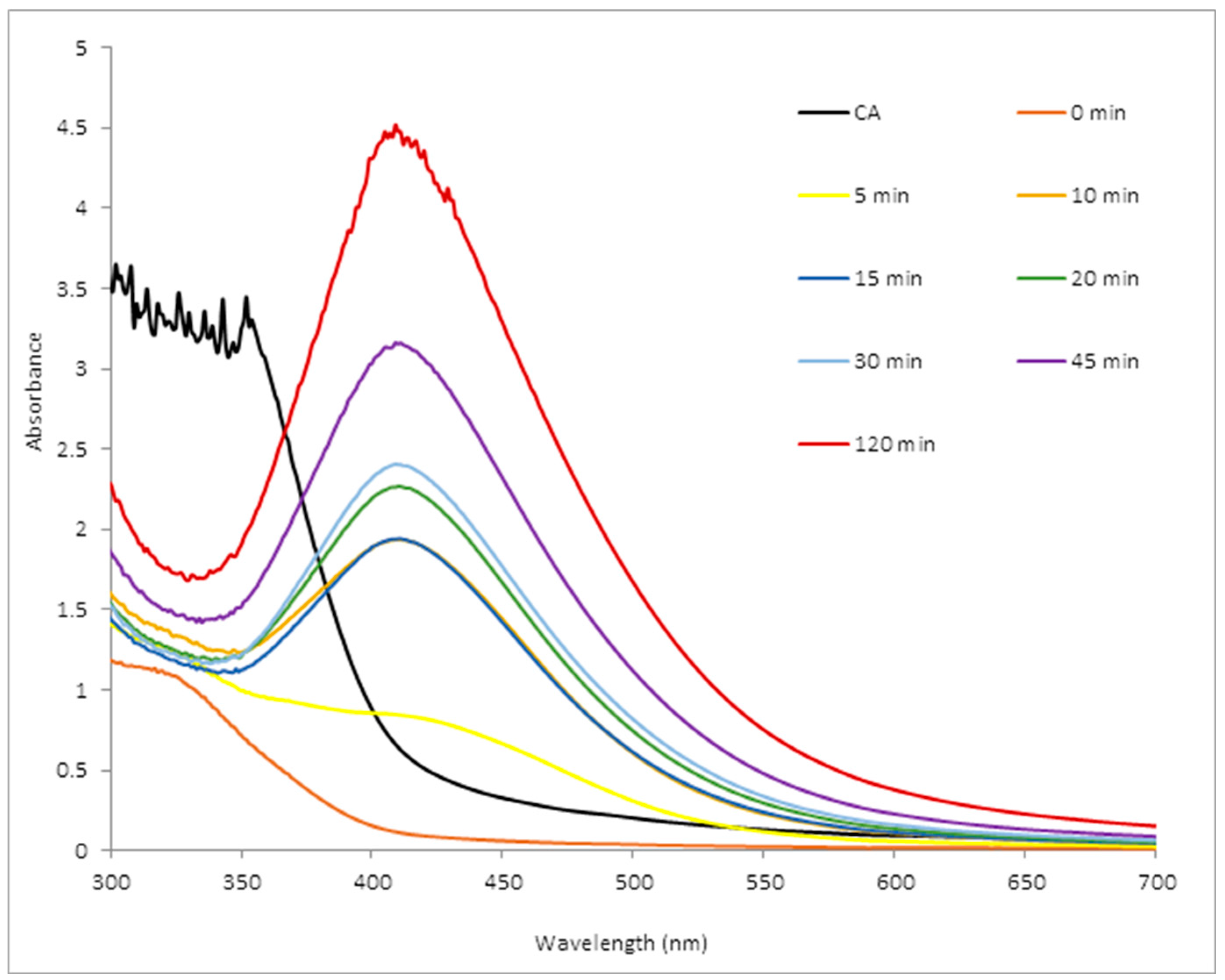
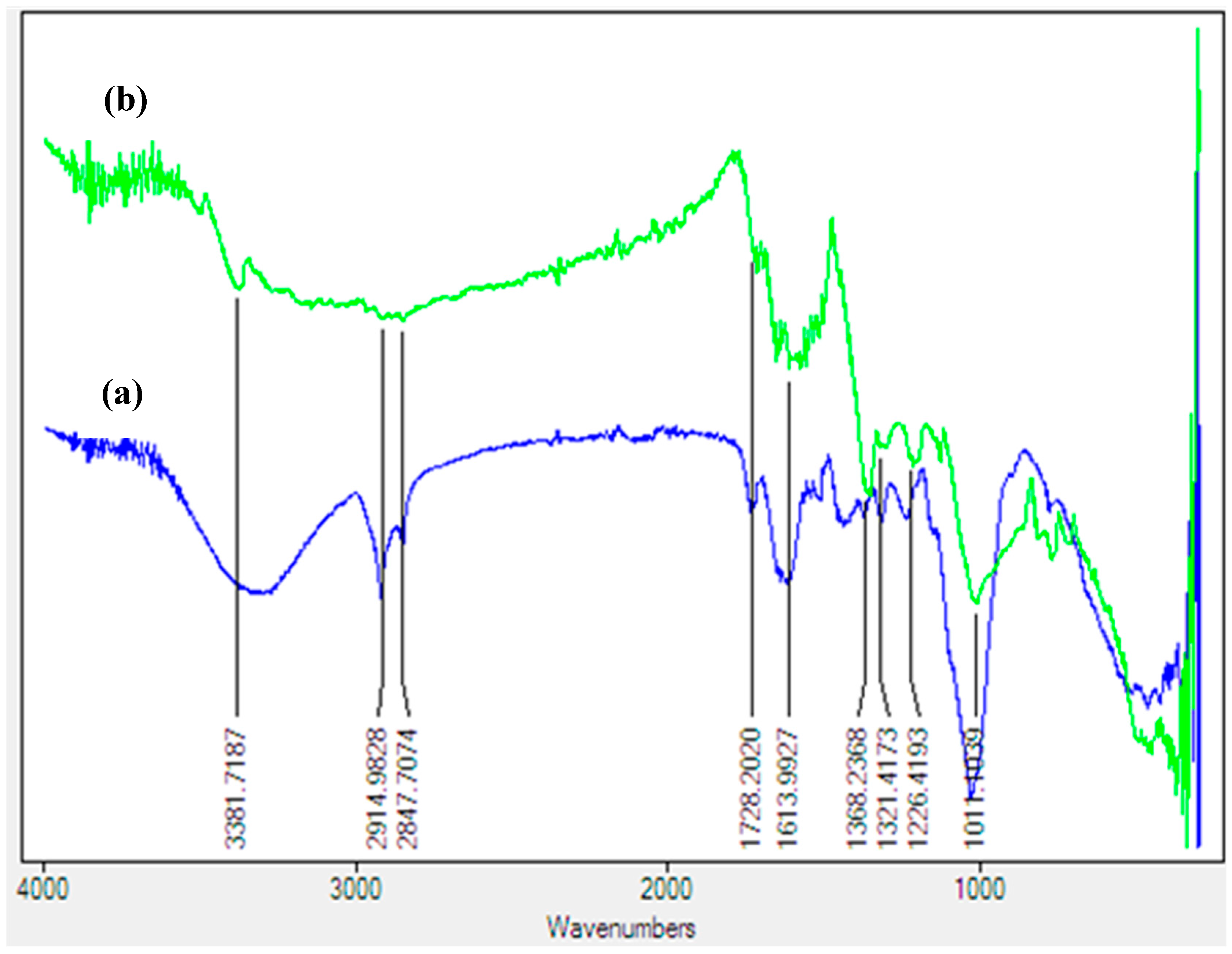
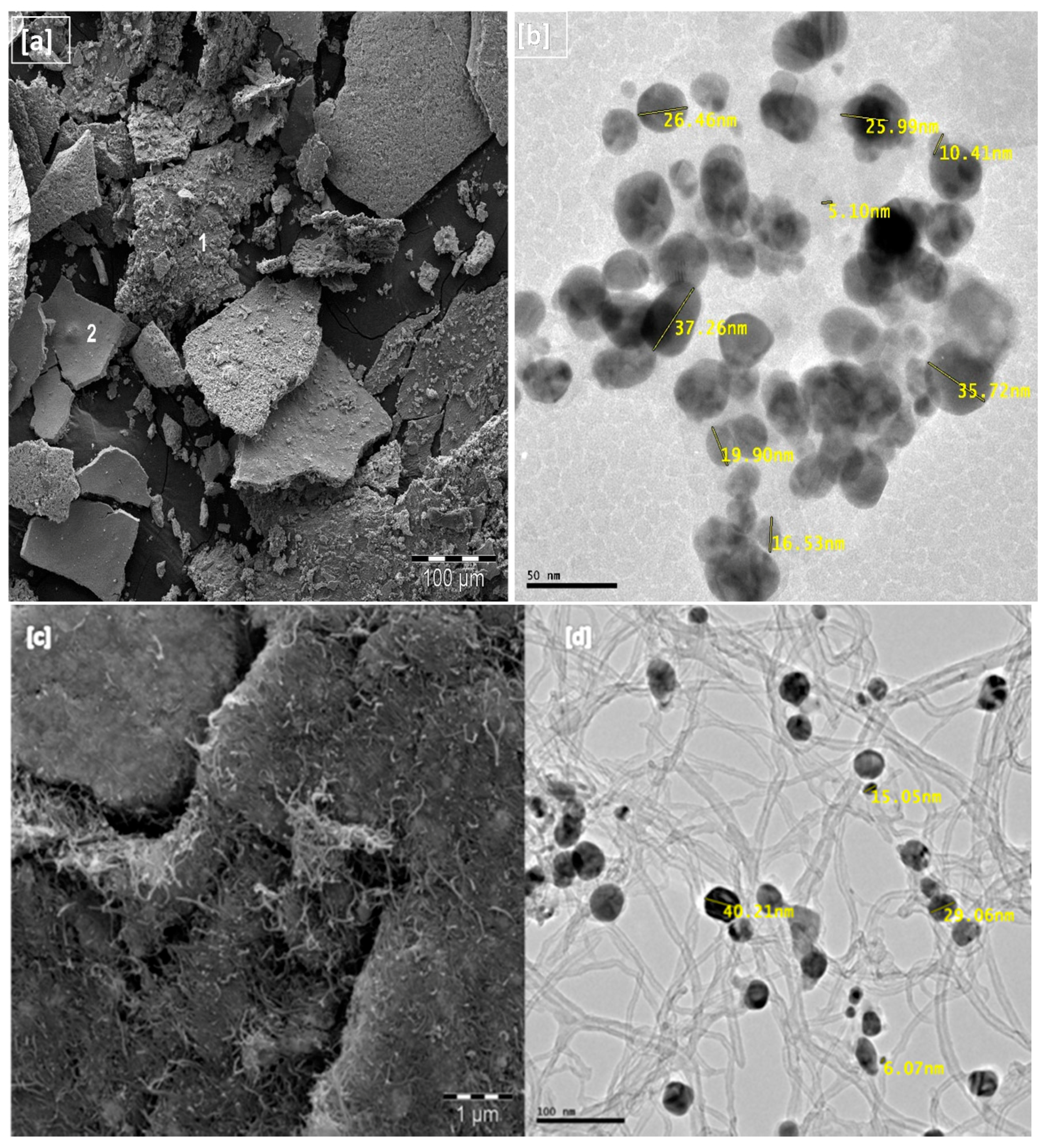
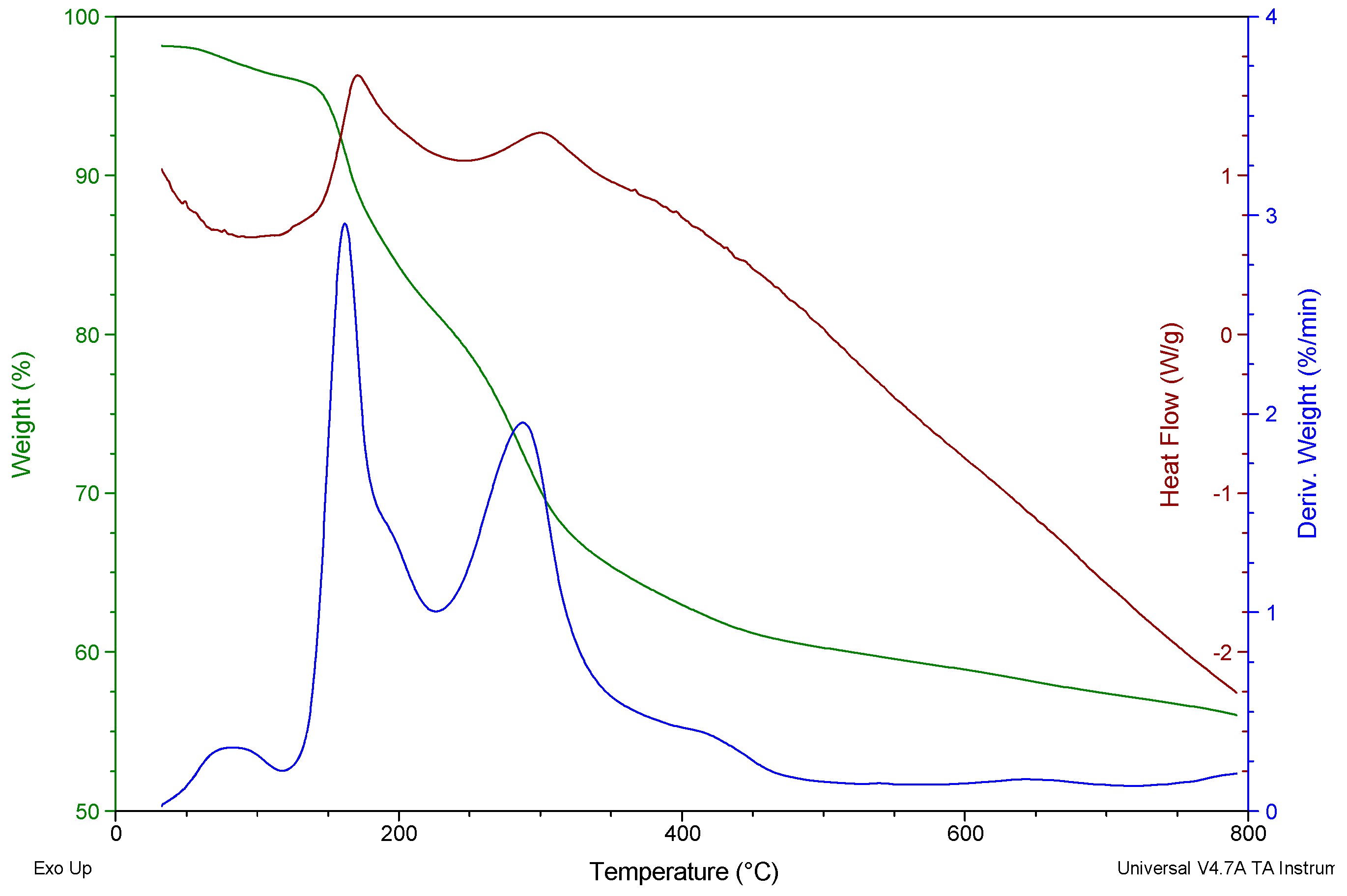
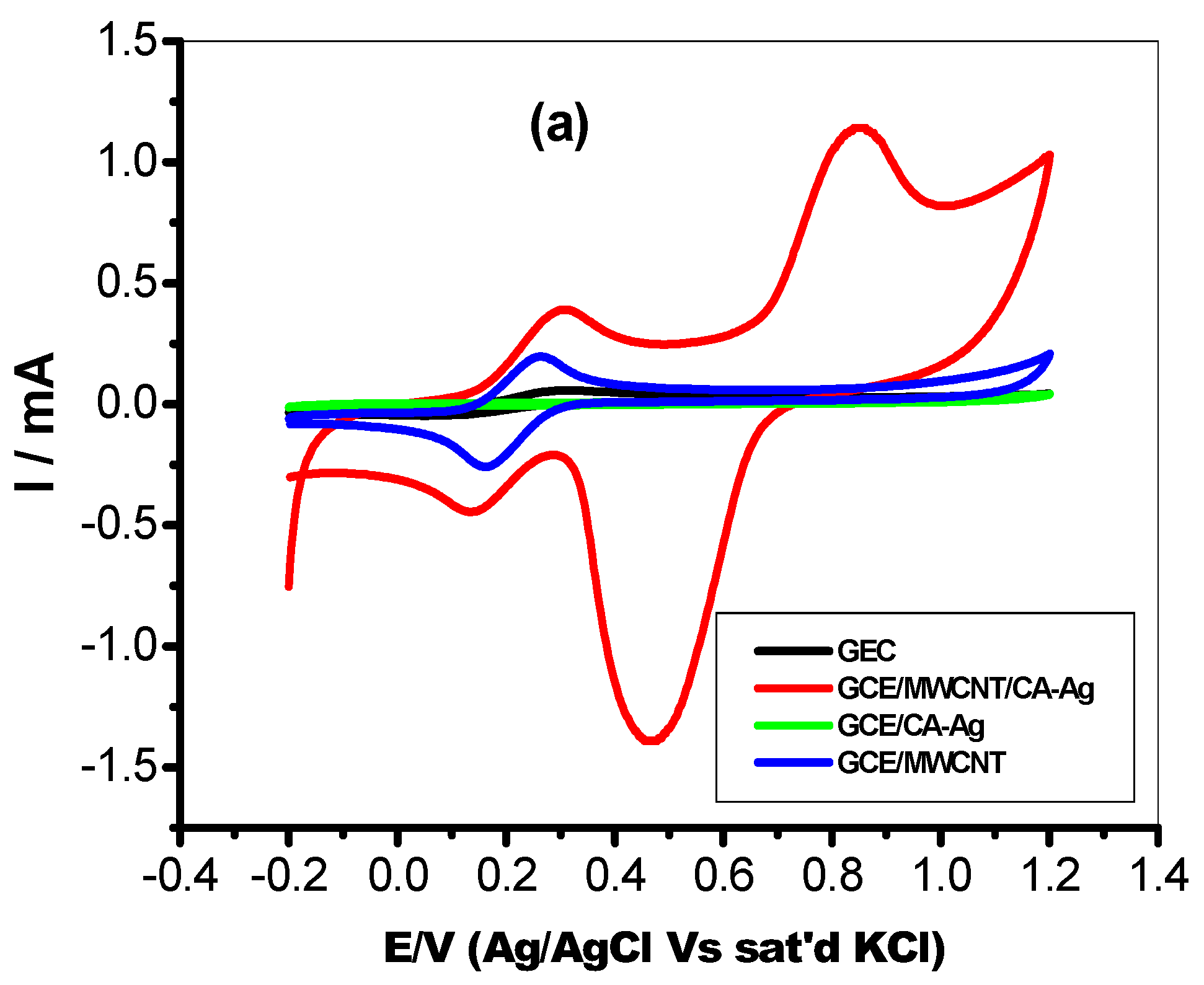
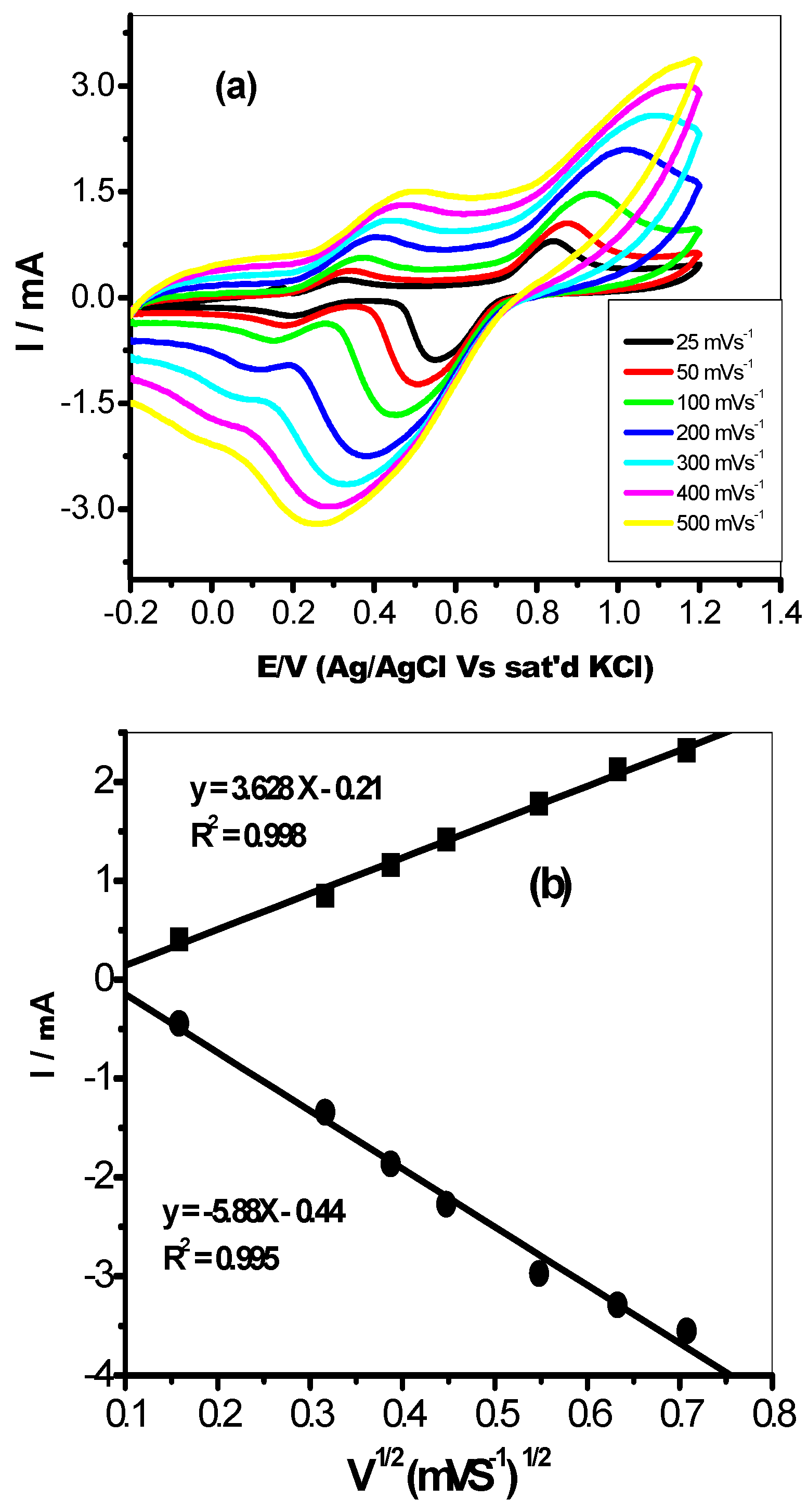
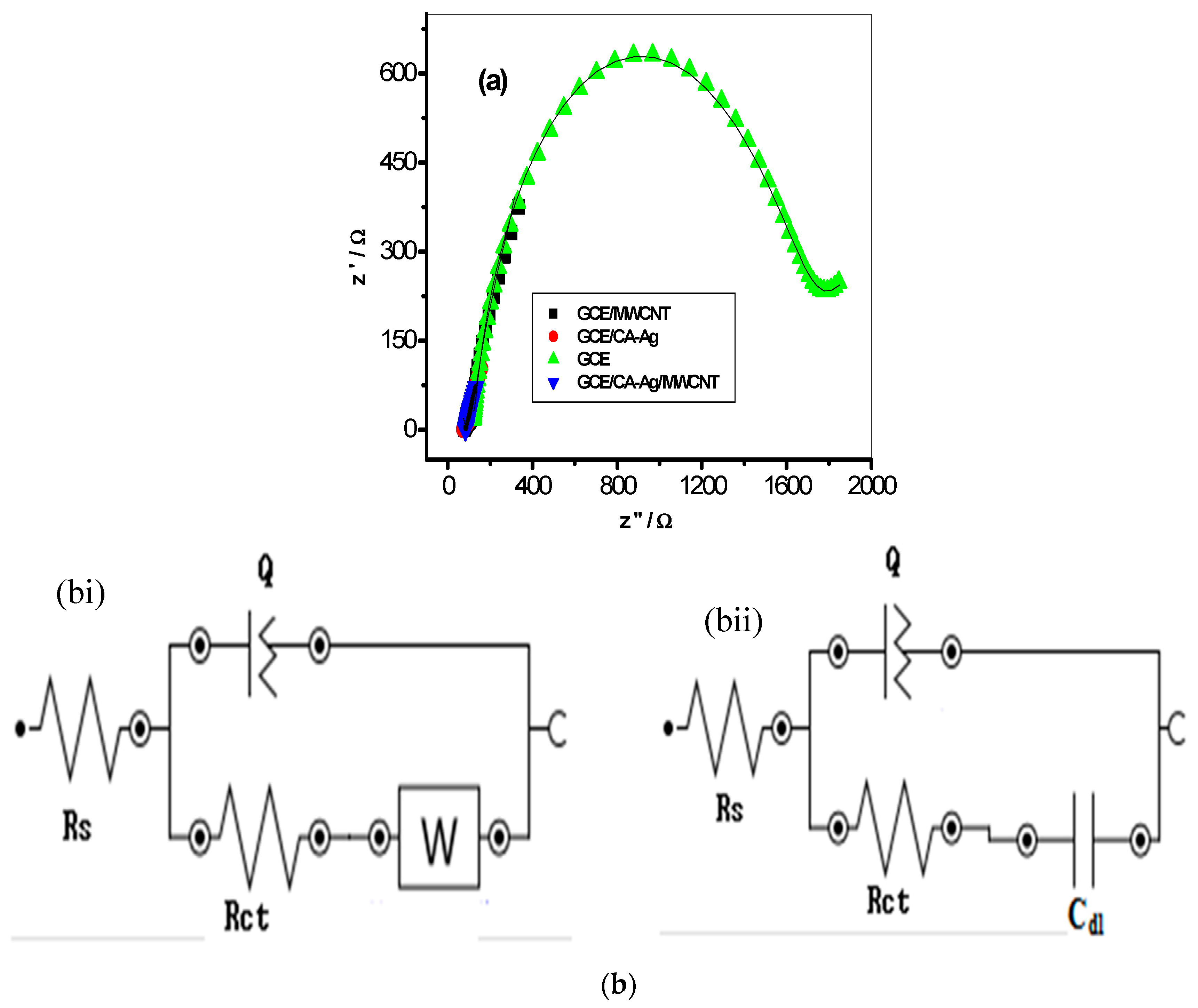
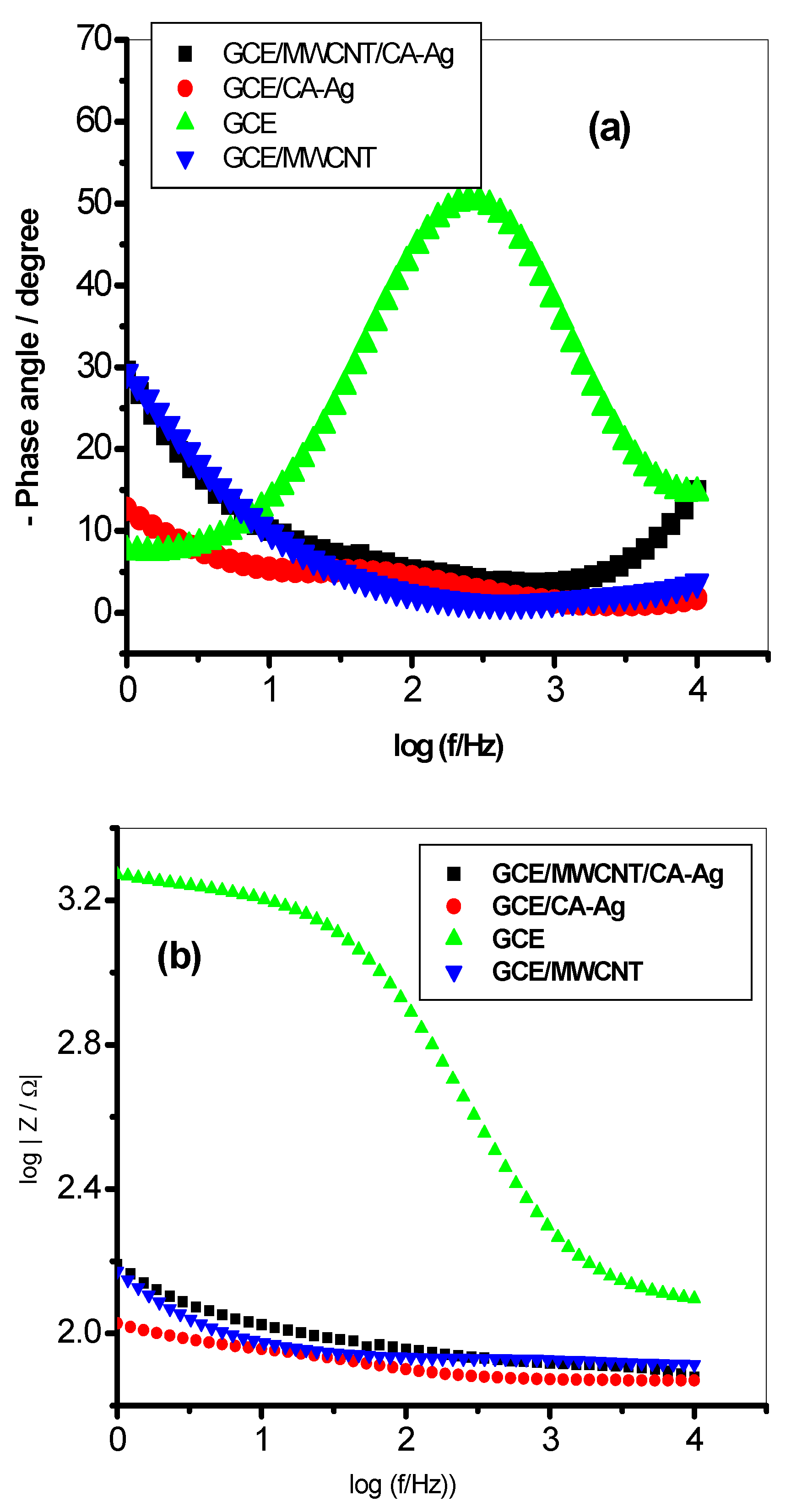
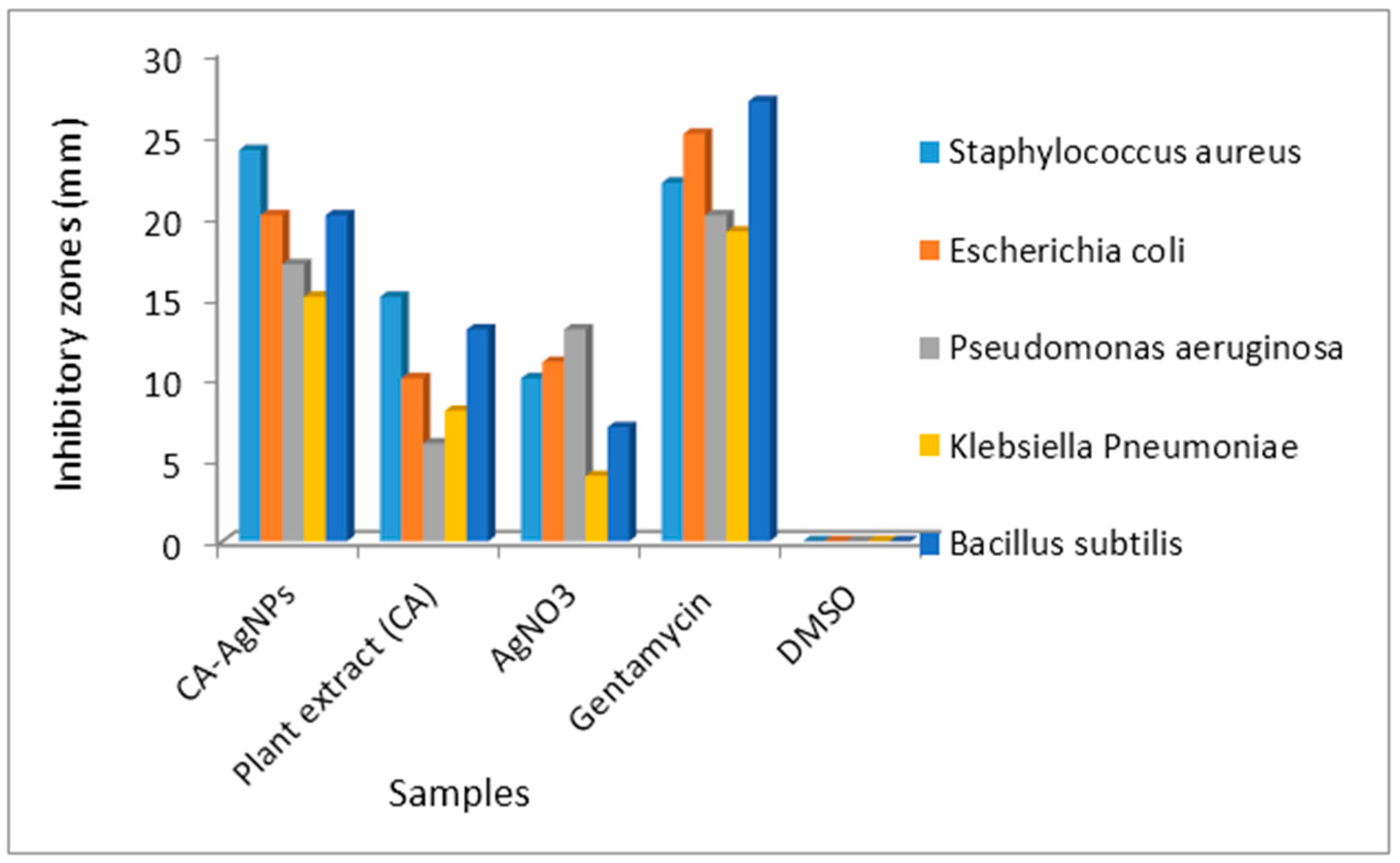
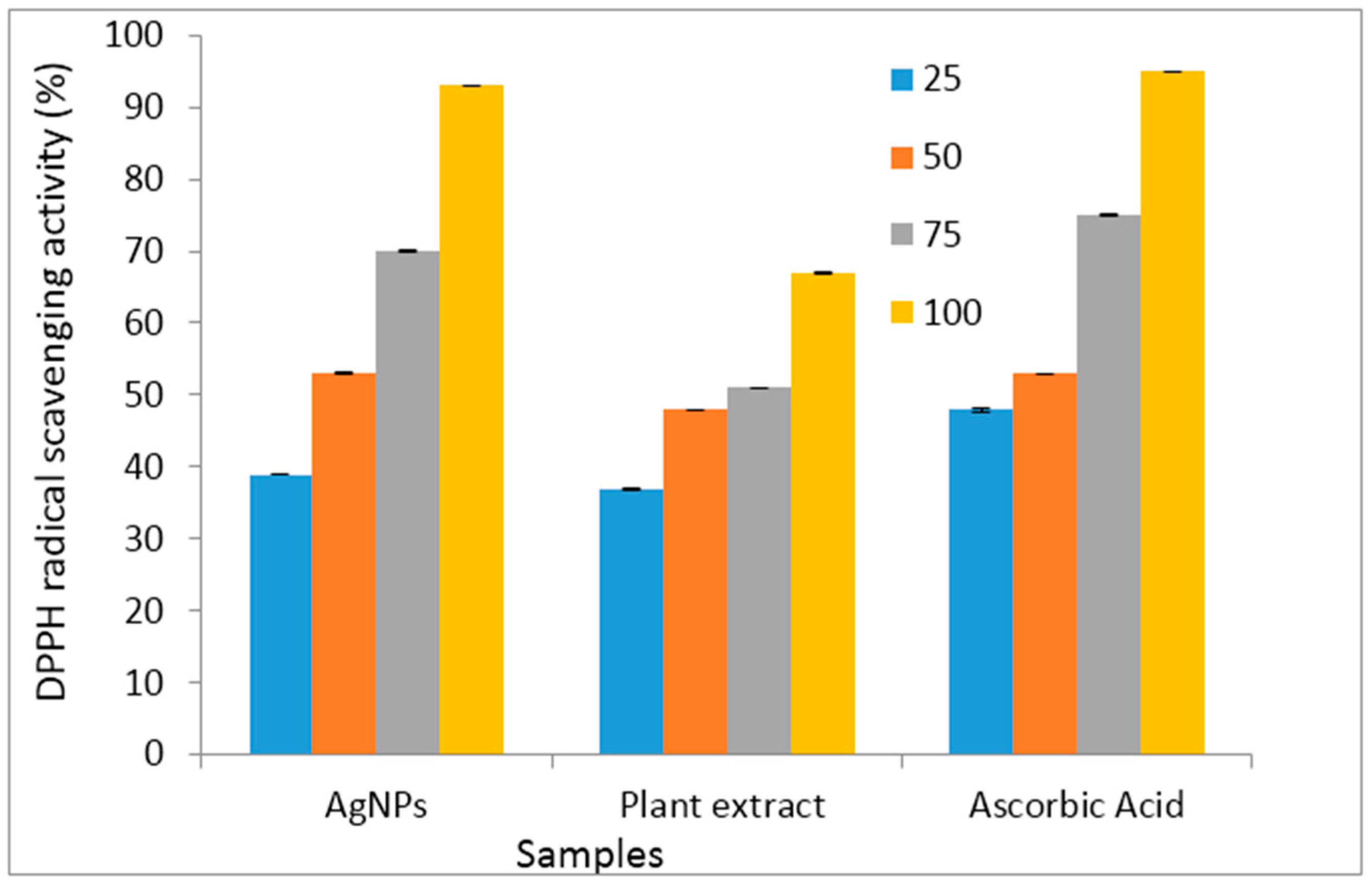
| Electrodes | Electrochemical Impedance Spectroscopy Data | |||
| Rs (Ω) | Q (×106 nF) | Rct (Ω) | W × 102 | |
| GCE | 116.10 (1.04) | 4.53 (4.05) | 1572.00 (1.14) | 0.14 (10.97) |
| Electrodes | Electrochemical Impedance Spectroscopy Data | |||
| Rs (Ω) | Q (×106 nF) | Rct (Ω) | Cdl (uF) | |
| GCE/MWCNT | 82.30 (0.59) | 0.36 (3.33) | 15.00 (27.05) | 302.10 (23.24) |
| GCE/CA-AgNPs | 72.20 (0.50) | 0.66 (2.52) | 76.50 (4.36) | 399.00 (4.65) |
| GCE/CA-AgNPs/MWCNT | 76.10 (2.37) | 0.21 (5.46) | 74.70 (11.74) | 100.30 (9.79) |
| Microbial Strains | MIC | Mean | Std. Deviation | Sig |
|---|---|---|---|---|
| Bacterial Strains | Samples | |||
| Staphylococcus aureus | CA-AgNPs | 23.00 a | 1.414 | 0 |
| Plant extract (CA) | 13.00 b | 2.828 | ||
| AgNO3 | 8.00 b,c | 2.828 | ||
| Gentamycin | 21.50 a,d | 0.707 | ||
| DMSO | 00.00 e | 0 | ||
| Escherichia coli | CA-AgNPs | 20.50 a | 0.707 | 0 |
| Plant extract (CA) | 10.50 b | 0.707 | ||
| AgNO3 | 12.00 b,c | 1.414 | ||
| Gentamycin | 24.00 a,d | 1.414 | ||
| DMSO | 00.00 e | 0 | ||
| Pseudomonas aeruginosa | CA-AgNPs | 17.50 a | 0.707 | 0 |
| Plant extract (CA) | 7.50 b | 2.121 | ||
| AgNO3 | 14.00 a,c | 1.414 | ||
| Gentamycin | 20.00 a,d | 0 | ||
| DMSO | 00.00 e | 0 | ||
| Klebsiella pneumoniae | CA-AgNPs | 14.00a | 1.414 | 0.001 |
| Plant extract (CA) | 11.00 a,b | 4.243 | ||
| AgNO3 | 4.00 b,c | 0 |
| Staphylococcus aureus | 10 μg/mL |
| Bacillus subtilis | 25 μg/mL |
| Pseudomonas aeruginosa | 25 μg/mL |
| Escherichia coli | 10 μg/mL |
| Klebsiella pneumoniae | 40 μg/mL |
| Concentration (μg/mL) | CA-AgNPs | Sig | Plant Extract (CA) | Sig | Ascorbic Acid | Sig |
|---|---|---|---|---|---|---|
| 25 | 39 ± 0.107 a | 0.000 | 37 ± 0.154 a | 0.027 | 48 ± 0.257 a | 0.001 |
| 50 | 53 ± 0.134 a | 48 ± 0.017 a,b | 53 ± 0.035 a,b | |||
| 75 | 70 ± 0.108 b | 51 ± 0.058 a,b,c | 75 ± 0.045 c | |||
| 100 | 93 ± 0.068 c | 67 ± 0.172 b,c | 95 ± 0.003 d |
© 2017 by the authors. Licensee MDPI, Basel, Switzerland. This article is an open access article distributed under the terms and conditions of the Creative Commons Attribution (CC BY) license (http://creativecommons.org/licenses/by/4.0/).
Share and Cite
Elemike, E.E.; Fayemi, O.E.; Ekennia, A.C.; Onwudiwe, D.C.; Ebenso, E.E. Silver Nanoparticles Mediated by Costus afer Leaf Extract: Synthesis, Antibacterial, Antioxidant and Electrochemical Properties. Molecules 2017, 22, 701. https://doi.org/10.3390/molecules22050701
Elemike EE, Fayemi OE, Ekennia AC, Onwudiwe DC, Ebenso EE. Silver Nanoparticles Mediated by Costus afer Leaf Extract: Synthesis, Antibacterial, Antioxidant and Electrochemical Properties. Molecules. 2017; 22(5):701. https://doi.org/10.3390/molecules22050701
Chicago/Turabian StyleElemike, Elias E., Omolola E. Fayemi, Anthony C. Ekennia, Damian C. Onwudiwe, and Eno E. Ebenso. 2017. "Silver Nanoparticles Mediated by Costus afer Leaf Extract: Synthesis, Antibacterial, Antioxidant and Electrochemical Properties" Molecules 22, no. 5: 701. https://doi.org/10.3390/molecules22050701
APA StyleElemike, E. E., Fayemi, O. E., Ekennia, A. C., Onwudiwe, D. C., & Ebenso, E. E. (2017). Silver Nanoparticles Mediated by Costus afer Leaf Extract: Synthesis, Antibacterial, Antioxidant and Electrochemical Properties. Molecules, 22(5), 701. https://doi.org/10.3390/molecules22050701







